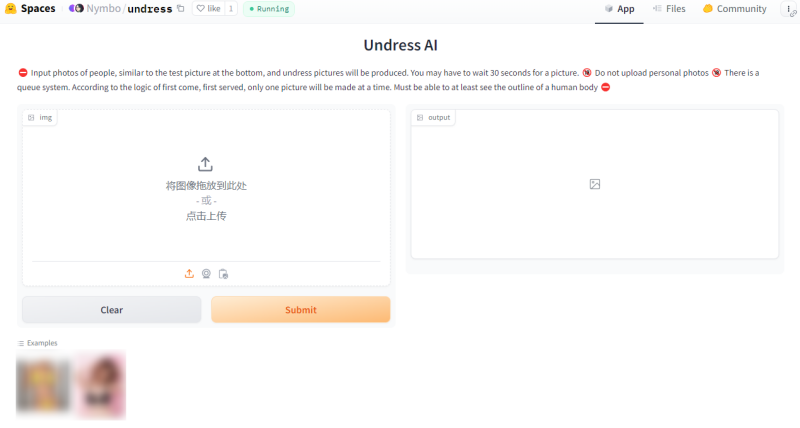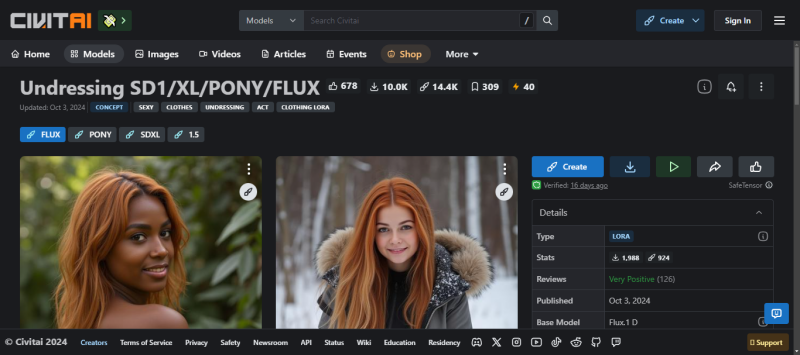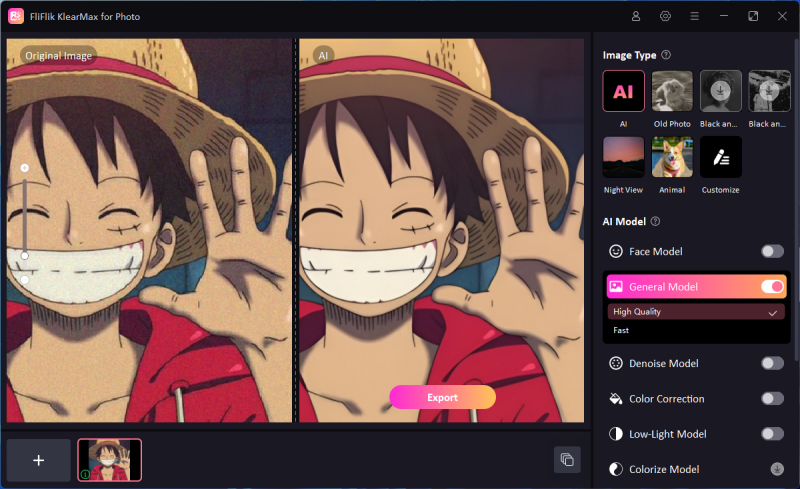Artificial intelligence (AI) has made incredible advancements, transforming numerous industries and enhancing human productivity. However, with every innovation comes the potential for misuse. One such controversial innovation is Undress AI a technology designed to digitally remove clothing from images, revealing the underlying body in a simulated fashion. While this may sound like science fiction, undress AI is now a reality, raising profound ethical and privacy concerns.
As undress AI becomes more accessible, it poses a significant threat to privacy, consent, and personal safety. From deepfake technology to image manipulation, the risks associated with these tools cannot be understated. With easy-to-use tools now available, even individuals with little technical expertise can exploit them, making it easier than ever to violate personal boundaries. This article will explore the potential dangers of undress AI, its common uses, leading tools, and free models for Stable Diffusion.
Risks and Ethical Concerns of Undress AI
Undress AI is a technology that can raise several critical ethical issues and risks, including:
1. Violation of Privacy
One of the primary concerns with undress AI is its blatant invasion of privacy. When someone’s image is manipulated to remove clothing without their consent, it constitutes a serious breach of personal boundaries. Individuals targeted by such tools often have no control over the digital manipulation of their likeness.
2. Consent Issues
Consent is the cornerstone of ethical technology use. Undress AI bypasses this by allowing users to undress images of individuals—without their knowledge or permission. This raises the question of whether a person has control over their image in a world where such manipulations are possible.
3. Exploitation and Harassment
The accessibility of undress AI tools has fueled concerns about online harassment. Unscrupulous users could take advantage of this technology to create humiliating or explicit content featuring their targets. Such actions can lead to severe emotional and psychological harm to the victims.
4. Legal and Regulatory Challenges
As the use of undress AI becomes more widespread, many governments and regulators are grappling with how to address it. Current laws surrounding image rights, consent, and privacy often lag behind technological advancements, creating a gray area where unethical practices flourish. Without stringent legal frameworks, it becomes harder to hold offenders accountable.
5. Gender-Based Misuse
While anyone can be a target, research suggests that undress AI is disproportionately used to exploit women. This technology has been weaponized to objectify and dehumanize women, turning them into targets for cyber harassment, bullying, and even blackmail. This deepens existing gender inequalities and reinforces harmful stereotypes.
Undress AI presents a unique ethical dilemma that needs immediate addressing. Its potential for harm is immense, and the debate about its responsible use must be led by technologists, policymakers, and ethicists alike.
The Common Use of Undress AI
Although we have been talked many potential risks of Undress AI, it can also be used in so many positive ways. Let us look at the common use of Undress AI.
1. Clothing Design and Virtual Fitting
Undress AI enables virtual clothing design and fitting by simulating how garments fit different body types. This helps designers visualize clothes on virtual models, streamlining the design process and reducing the need for physical prototypes.
2. Film and Television Production and Special Effects
In film and TV, undress AI assists with creating realistic digital doubles or altering costumes without reshooting scenes. It enhances special effects by adjusting characters’ clothing or appearances seamlessly, contributing to more dynamic storytelling.
3. Medical and Health
Undress AI is used in medical imaging to simulate anatomical models, aiding in patient education and surgical planning. It allows precise visualization of underlying body structures, improving diagnoses and healthcare outcomes.
4. Ergonomics and Motion Analysis
In ergonomics, undress AI analyzes body movements and posture by digitally removing clothing to assess muscle and joint functions. This data is critical for improving product design, workplace safety, and athletic performance through biomechanical insights.
5. Art and Entertainment
Undress AI is used in digital art, gaming, and animation to create more realistic human models and interactions. It facilitates creative expression by allowing artists and developers to simulate and customize human figures in a dynamic, virtual environment.
6. Fitness and Personal Training
Undress AI helps trainers analyze body composition and muscle movement by providing a clearer view of the client’s anatomy. This enables more accurate fitness tracking, personalized exercise recommendations, and injury prevention strategies.
Top 2 Undressing AI Tools
There are several undress AI tools available online, each varying in features and usability. Two popular ones are SeaArt and Nymbo.
1. SeaArt

SeaArt is one of the most well-known undress AI tools available online. It markets itself as an artistic tool for creating hyper-realistic, digitally remove clothes from images. The platform is highly intuitive and offers various customization features, allowing users to modify images with relative ease.
Key Features:
- User-Friendly Interface
- High-Resolution Output
- Customization Options
However, despite its marketing as an artistic tool, SeaArt’s potential for misuse remains high, and its accessible nature raises ethical questions about its availability.
2. Nymbo

Nymbo is another AI tool that specializes in creating undressed versions of images, publishing on Hugginface. Unlike SeaArt, Nymbo is entirely free and open source but operates at a slower pace, which may deter some users looking for faster results.
Key Features:
- Free Access
- Low Speed
- Minimalistic Design
Nymbo’s free access makes it a popular choice among users, but like all undress AI tools, it carries the same ethical risks, especially in terms of misuse for harassment or revenge.
Free Undress AI Models for Stable Diffusion
Address: https://civitai.com/models/505266/undressing-sd1xlponyflux
For users who prefer open-source options, there are free Undress AI models available for Stable Diffusion, a text-to-image generative model. One such model is Undressing SD1/XL/PONY/FLUX, which can be found on platforms like CivitAI.

This model is designed to work with the Stable Diffusion framework, allowing users to generate undressed images using AI-powered algorithms.
Key Features:
- Stable Diffusion-Based: Stable Diffusion is an advanced AI model that produces highly realistic images based on textual prompts. The undressing model builds on this foundation to deliver impressive results.
- Customizable Results: Users can tweak various parameters, such as body shape, skin tone, and pose, to achieve a tailored final image.
- Wide Compatibility: This model is compatible with a range of platforms and can be integrated into personal projects for experimentation or further development.
While the Undressing SD1/XL/PONY/FLUX model is an impressive feat of AI, it raises the same ethical concerns as other undress AI tools. Open-source models like these allow developers to tweak and customize them, potentially amplifying their misuse.
Great AI Tool to Upscale Images to 8K for Stable Diffusion

To complement undress AI models used in Stable Diffusion, users often require a tool to upscale their images to higher resolutions for better clarity and detail. One such tool is FliFlik KlearMax for Photo, designed for high-quality image enhancement. KlearMax for Photo is a powerful AI-based image upscaling tool that enables users to transform low-resolution images into stunning, ultra-high-definition 8K versions. You can also upscale the images to HD, 2K, and 4K resolution. Additionally, this tool can also repair blurry, pixelated and low quality pictures.
This tool is particularly useful for users who need to generate highly detailed images, such as in fashion or virtual design. While it may not directly relate to undress AI, it can be used to improve the quality of any images generated through AI models.
Conclusion
Undress AI represents one of the more controversial applications of artificial intelligence, with potential for severe ethical and privacy violations. As tools like SeaArt and Nymbo become increasingly accessible, the risks of misuse rise dramatically, creating a new set of challenges for individuals, law enforcement, and regulators. Furthermore, the availability of free models like Undress SD1/XL/PONY/FLUX only amplifies the spread of such technology. While undress AI may have niche applications, its overwhelming potential for harm necessitates strict ethical guidelines and robust legal frameworks.
FREE DOWNLOAD
Secure Download
FREE DOWNLOAD
Secure Download
